Driven by falling fuel prices and the tightening policies, introduced recently by the Federal Reserve, inflation is finally slowing down in the U.S. However, grocery prices in the U.S. remain sky-high – data by the U.S. Bureau of Labor Statistics revealed food-at-home soared 13.5% in August, the largest annual increase since March 1979.
Despite the drop in overall inflation, groceries will most likely stay at their current high levels for a long time. This prompted our team at TradingPedia to examine some of the major grocery chains in the US. We analyzed price data as of September 20, 2022 for Walmart, Albertsons and Target in order to highlight the best and most affordable places to shop per grocery category.
To create a virtual shopping cart, i.e. a simplified version of the market basket used in economy and market analysis, we took 37 food products from the following categories:
- Bakery
- Meat and seafood
- Fruits and vegetables
- Beverages
- Condiments/Sauces
- Dairy and eggs
- Canned foods
- Frozen foods
- Crisps, snacks, nuts, and popcorn
The overall results for the entire basket vary by 12.65%:
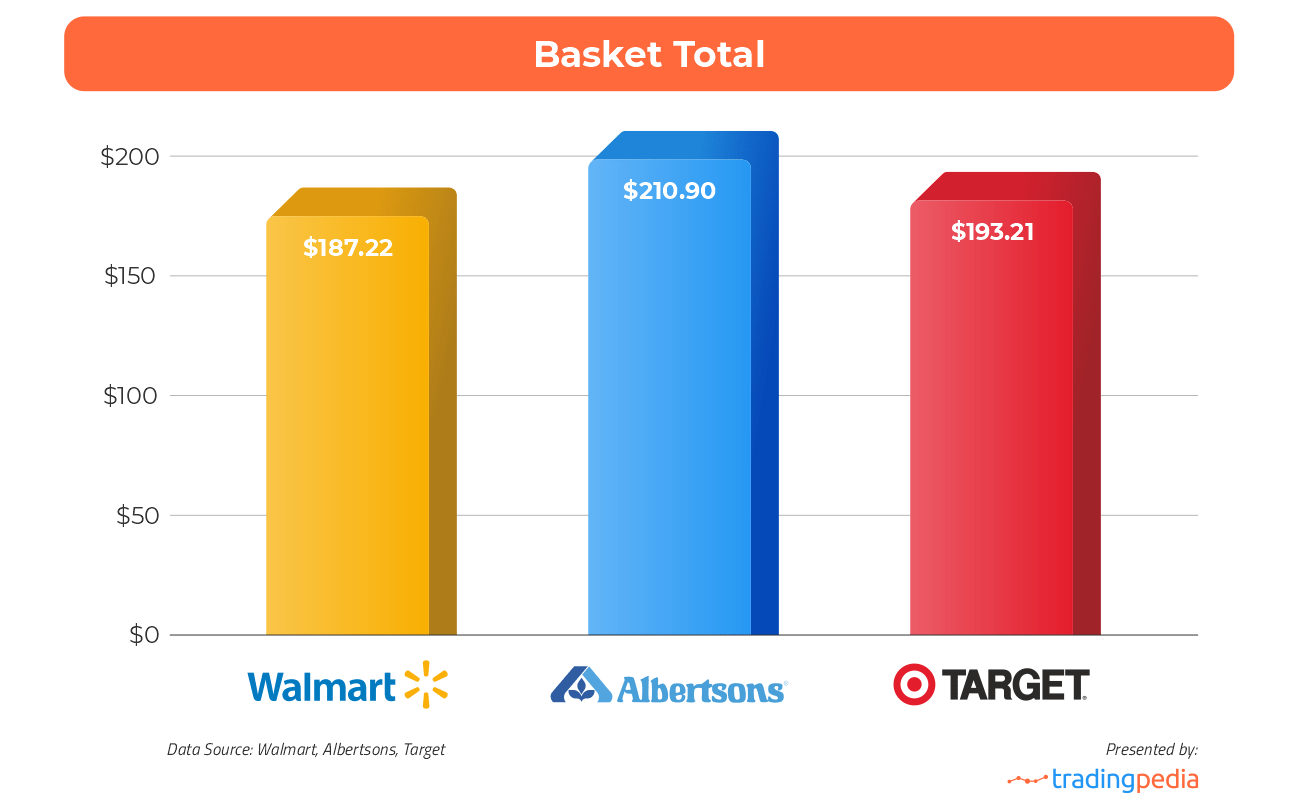
In order to be as accurate as possible, for this research we picked well-known items from each food group and category, such as King’s Hawaiian Original Hawaiian Sweet Rolls and Babybel Original Cheese, and compared their prices at Walmart, Albertsons and Target.
According to the overall price for all 37 items in our virtual shopping cart, the most affordable grocery store among the surveyed is Walmart with a total of $187.22.The same products will cost you $193.21 at Target. And with a difference of $23.68 compared to Walmart, it will cost you the most to shop at Albertsons – $210.90 for all 37 food items. The overall results vary by 12.65% but when we look into the different categories we see quite larger price differences:
Fruits & Vegetables vary the most at 41%
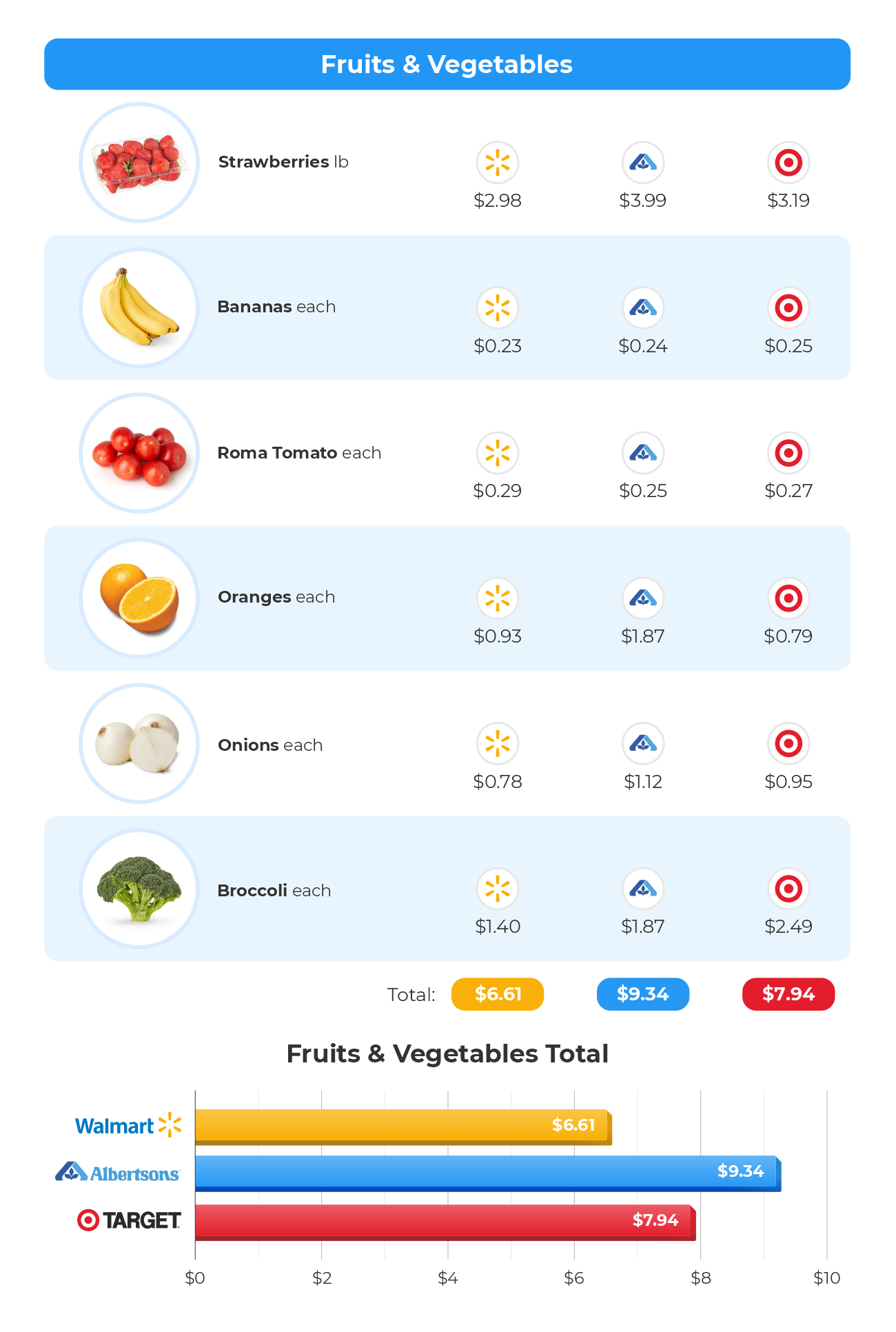
Comparing product prices, we can see a huge contrast between the cheapest and the most expensive items in certain categories. The six items within the Fruits and Vegetables category, for example, cost a total of $6.61 in Walmart, while their price would be 41.30% higher if we shopped at Albertsons where they are available for $9.34. Those same products would cost us $7.94 at Target.
38.43% Price Difference for Snacks
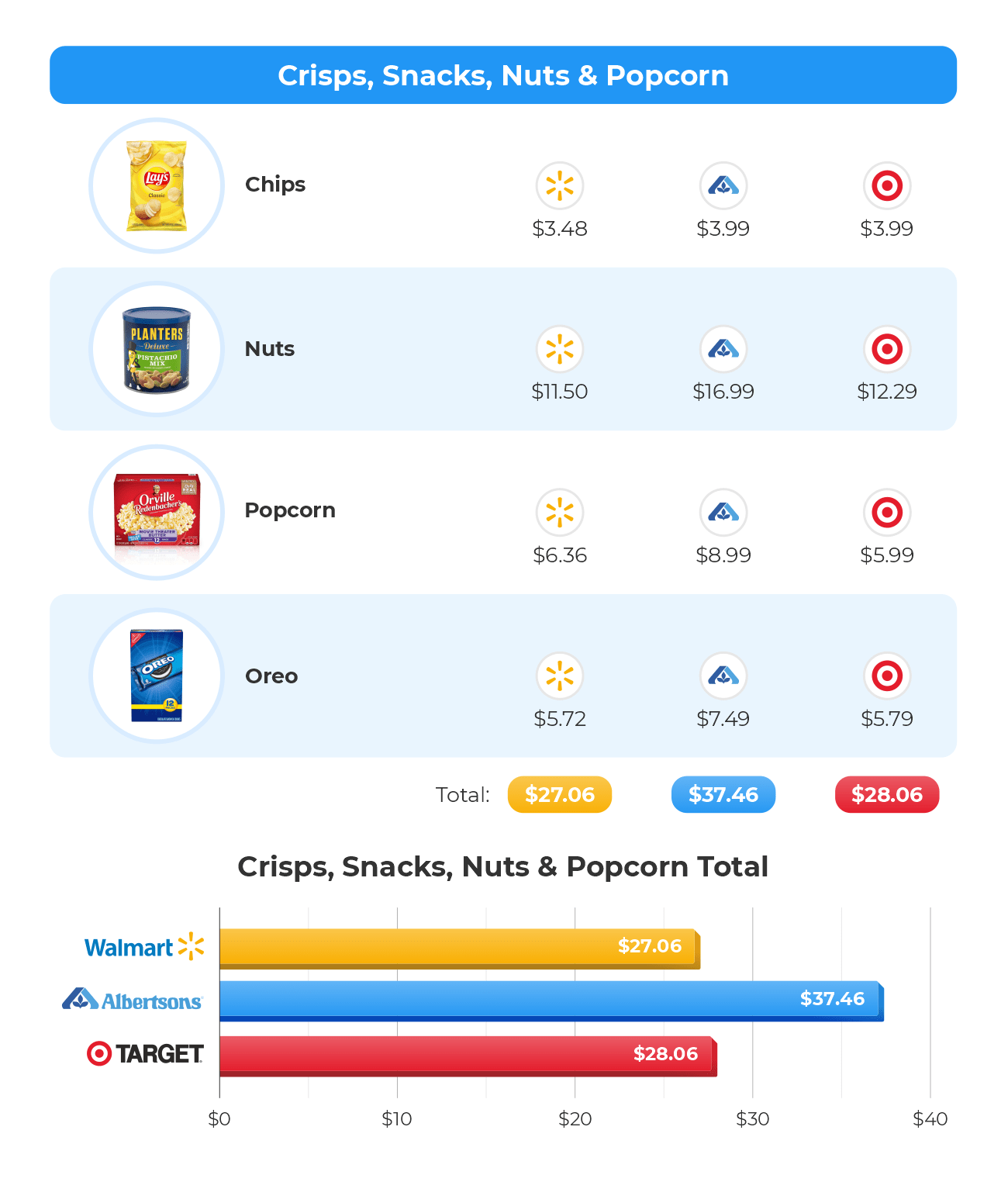
There is also a significant difference among the prices within the Snacks category. For some chips, nuts, popcorn, and a 12-pack of Oreos, we would pay $27.06 in Walmart. Filling our shopping cart with the same items at Albertsons, we have to be prepared to pay over ten dollars more or $37.46, which is a difference of 38.43%. Meanwhile, the bill at Target for those exact same products would show $28.06.
Paying 24.41% More for Beverages
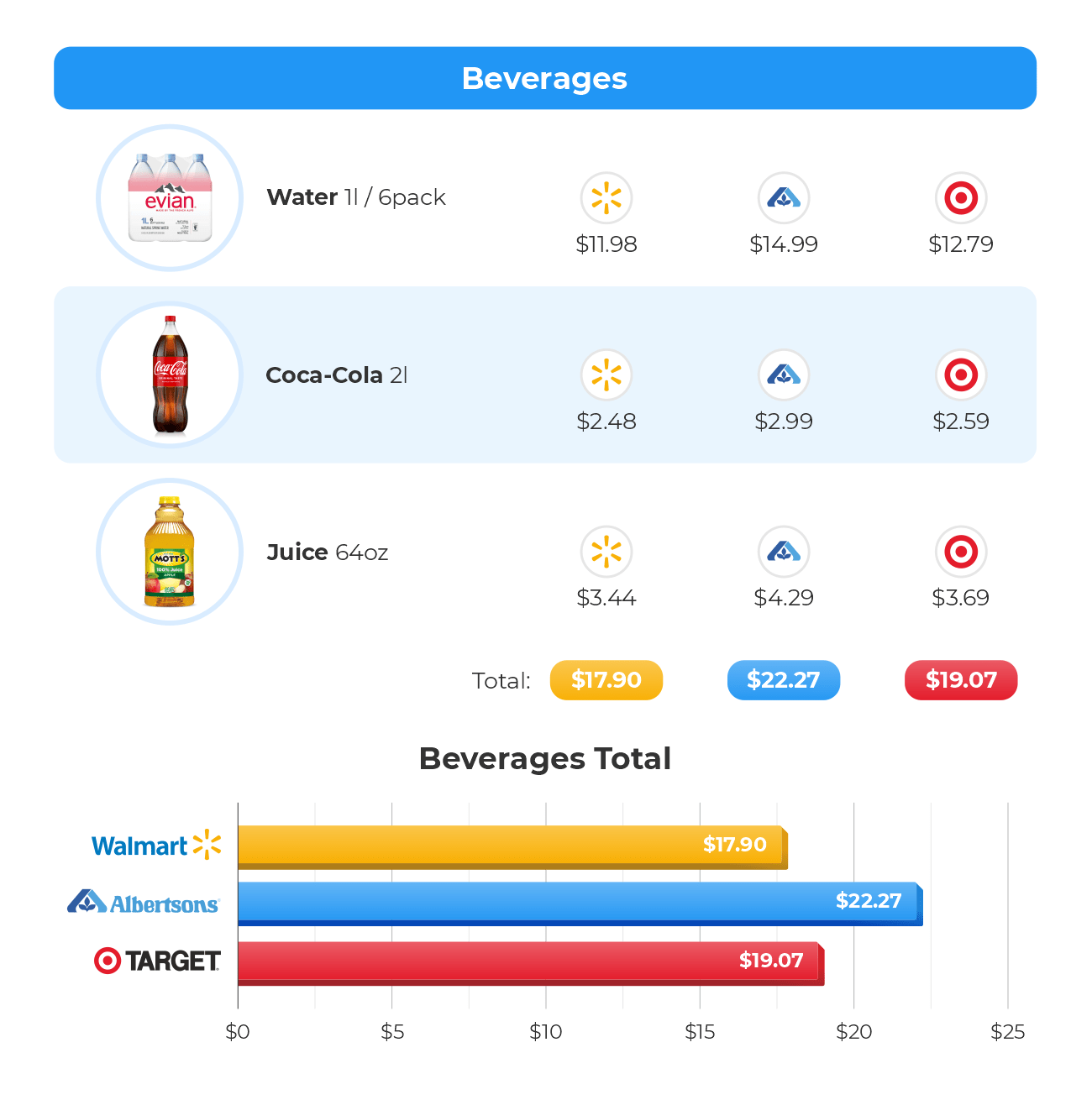
Let’s put a handful of popular beverages in our shopping cart, as well – a bottle of water, a Coca Cola, and a 64oz bottle of orange juice. The price for the trio will be $17.90 in Walmart compared to $19.07 in Target. If we buy them from Albertsons, they will cost us $22.27, or 24.41% more than Walmart.
16.93% Difference within Dairy & Eggs category
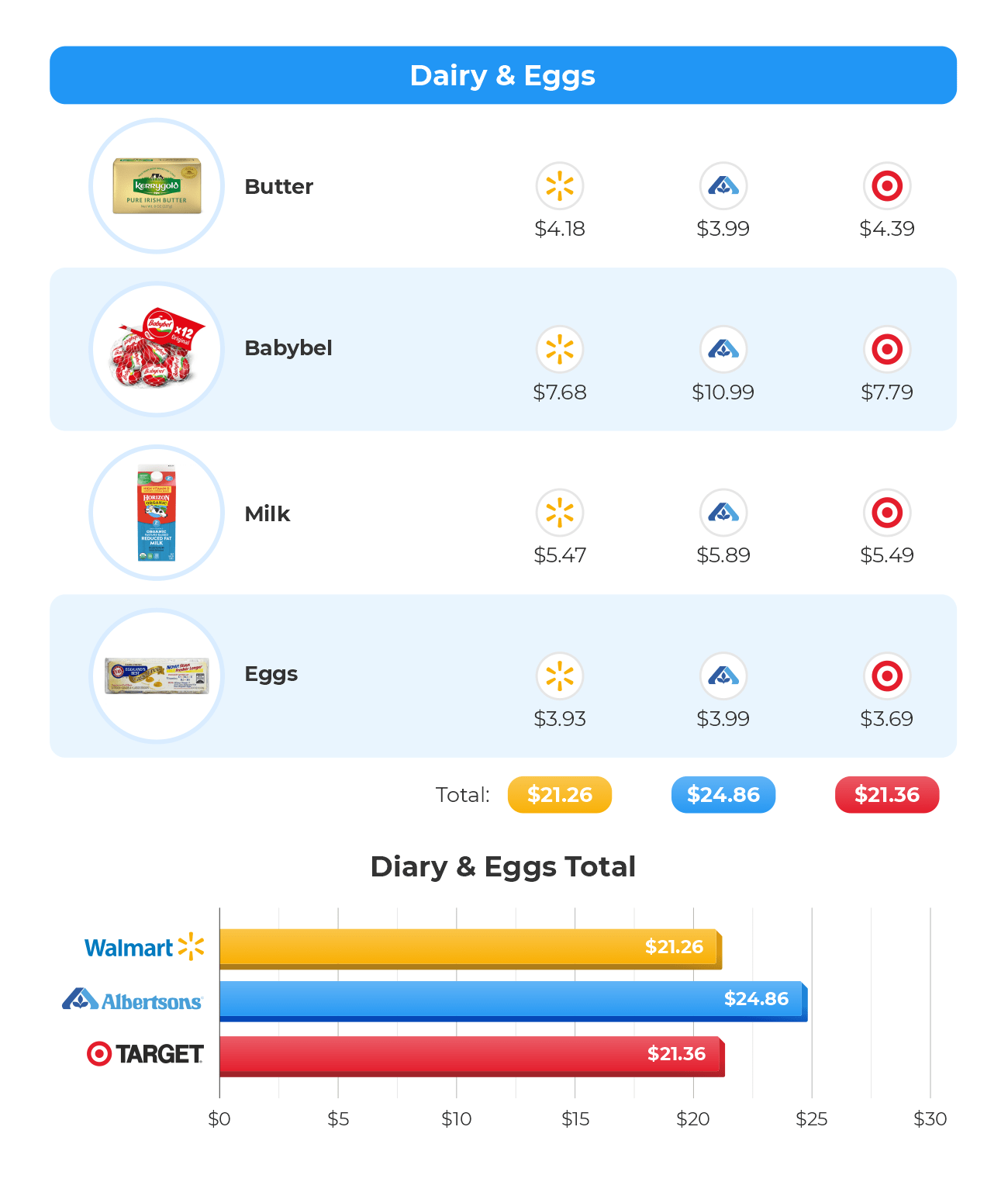
Within the Dairy and Eggs category, the price difference is not as large and for four items, namely butter, milk, eggs, and Babybel cheese, we would pay just a few dollars more if we choose the most expensive option. This would be Albertsons, once again, where for these four basic products, we will have to pay $24.86. The same bill at Walmart will be $21.26 and $21.36 at Target. This puts Albertsons prices at 16.93% higher than Walmart.
12.62% More for Basic Canned Foods
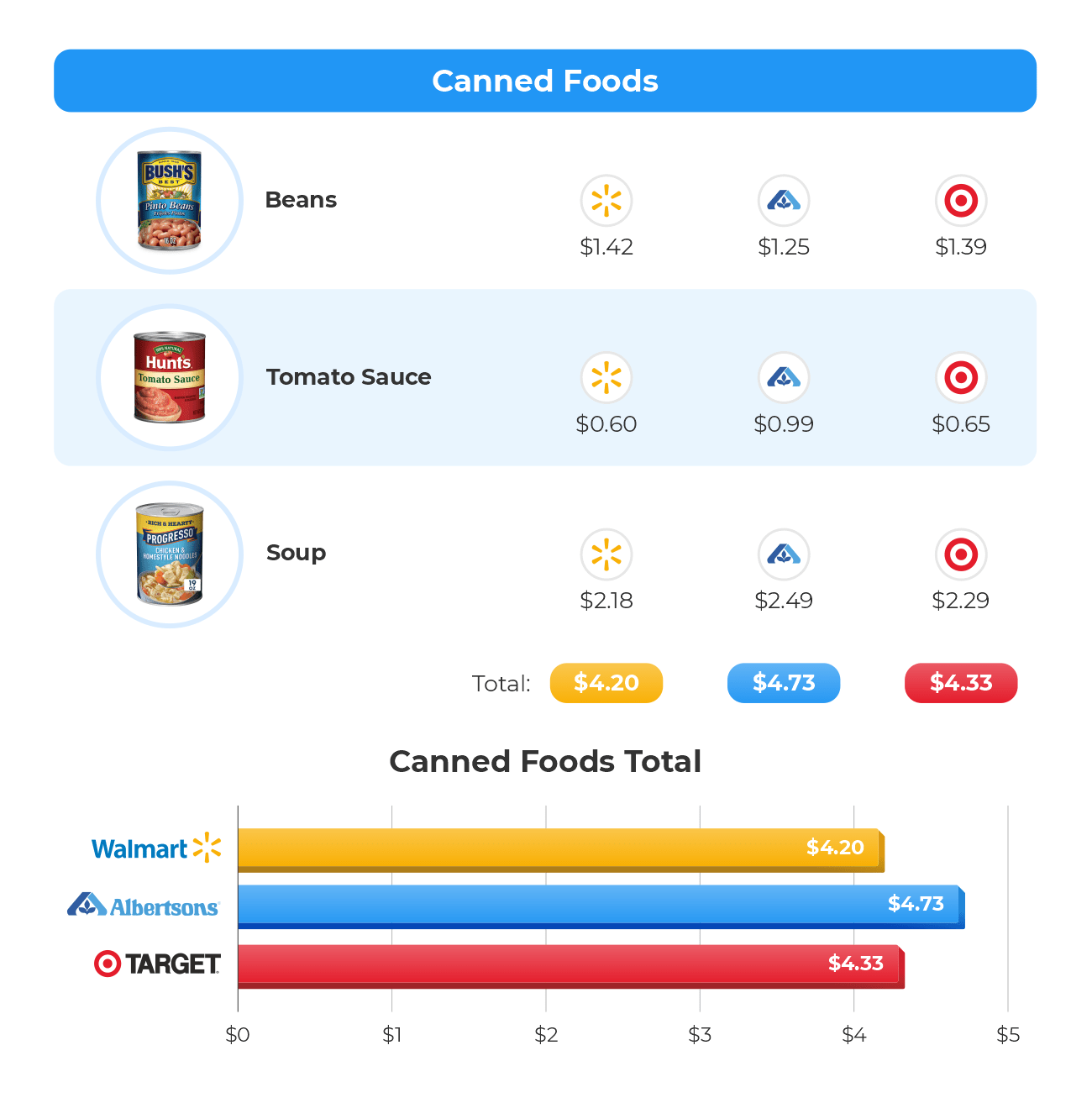
The prices of basic canned foods such as beans, tomato sauce, and everybody’s favorite chicken noodle soup are very similar at all three stores we surveyed. A 12.62% price difference wouldn’t make you reconsider where to do your weekly shopping if you buy just one or two cans as most people do. The three products within this category cost only $4.20 at Walmart, $4.33 at Target, and $4.73 at Albertsons.
Meat & Seafood differs by 11.08%
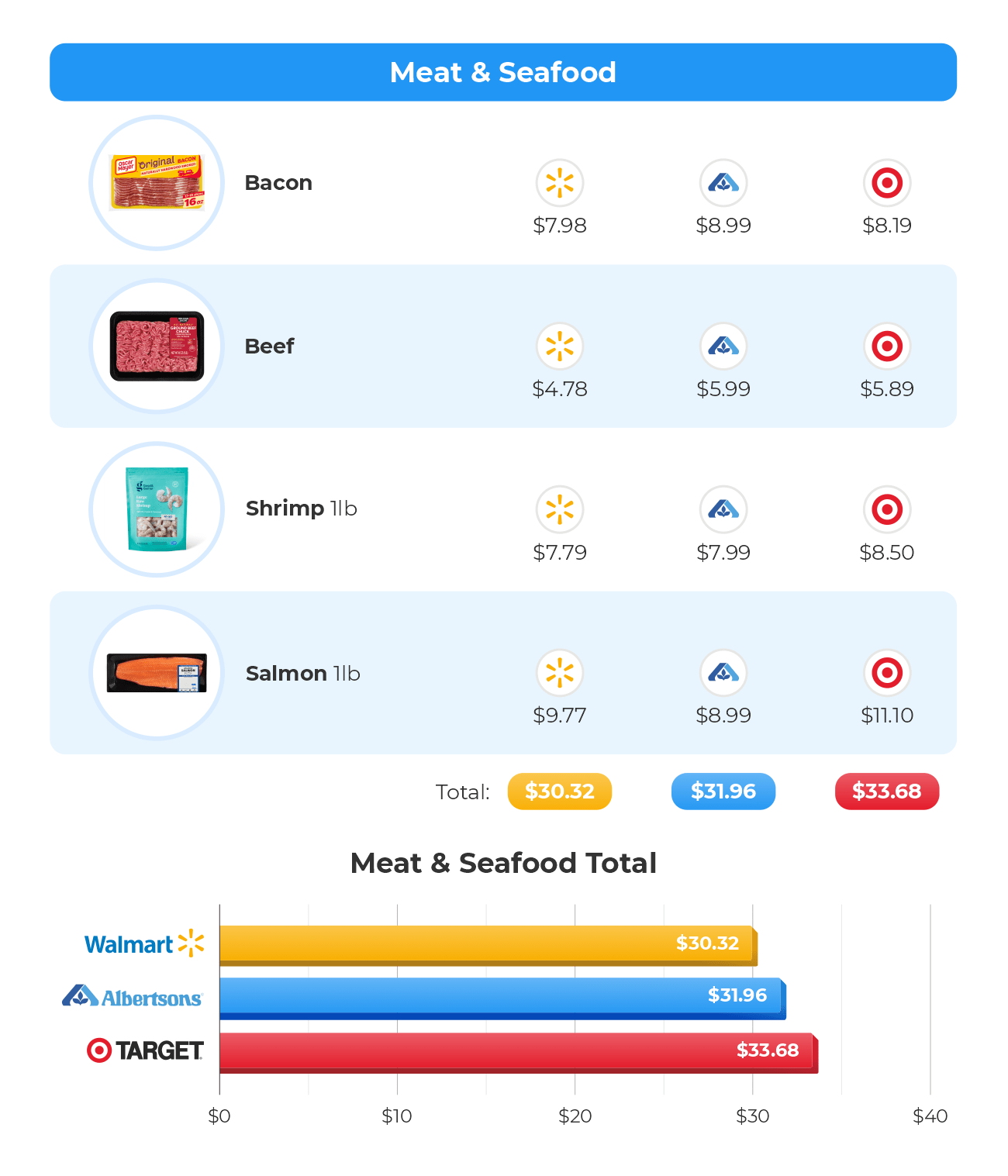
The meat and seafood we’ve picked for this survey comes at almost identical prices at the three different stores. In terms of dollar value, the difference between the highest and lowest priced items may matter to some frugal shoppers who do their groceries in bulk. Percentage-wise, the difference stands at 11.08%. For some bacon, ground beef, frozen shrimps, and fresh salmon, we will need to pay $30.32 at Walmart, $31.96 at Albertsons, and $33.68 at Target.
10.26% Price Difference within the Bakery Category
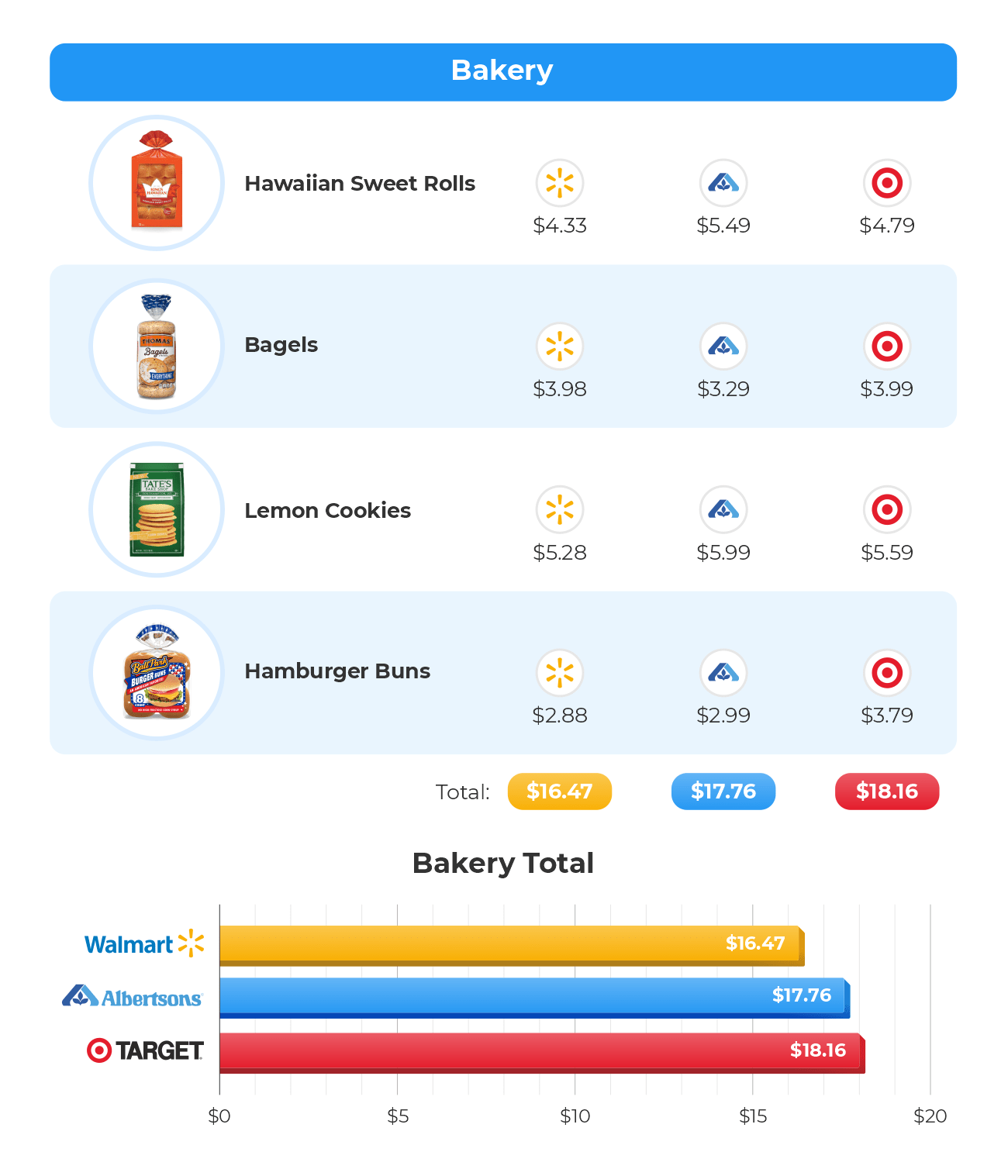
Our virtual shopping cart also includes a package of bagels, lemon cookies, some hamburger buns, and Hawaiian sweet dinner rolls. Once again, there isn’t a huge difference in the prices of bakery items in the three stores we examined. Interestingly, Target’s prices here are the highest of all, even if just by a bit – these four items sell for $18.16 at Target, $17.76 at Albertsons, and $16.47 at Walmart (10.26% price difference compared to Target).
Condiments price difference is 10.07%
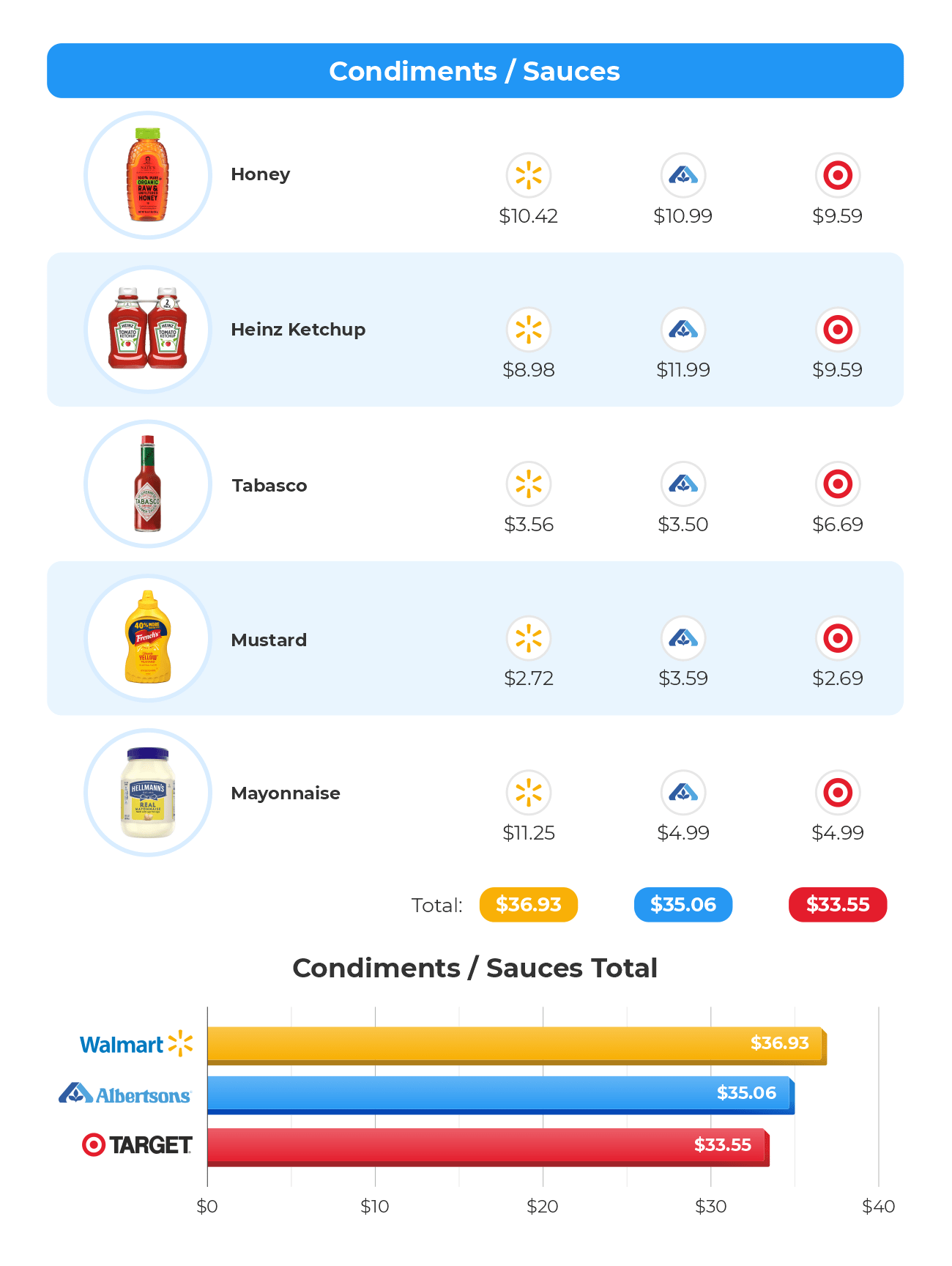
So far, Walmart has been the most affordable place to grocery shop from the three stores we analyzed. However, it has the highest total cost for the products within the condiments and sauces category. These include ketchup, mustard, and mayo, as well as honey and Tabasco sauce. For these four, Target would bill us $33.55, while at Albertsons, we would have to pay $35.06. The price at Walmart is $36.93 or 10.07% more than what is sold at Target.
Similar Prices for Frozen Foods in All 3 Stores
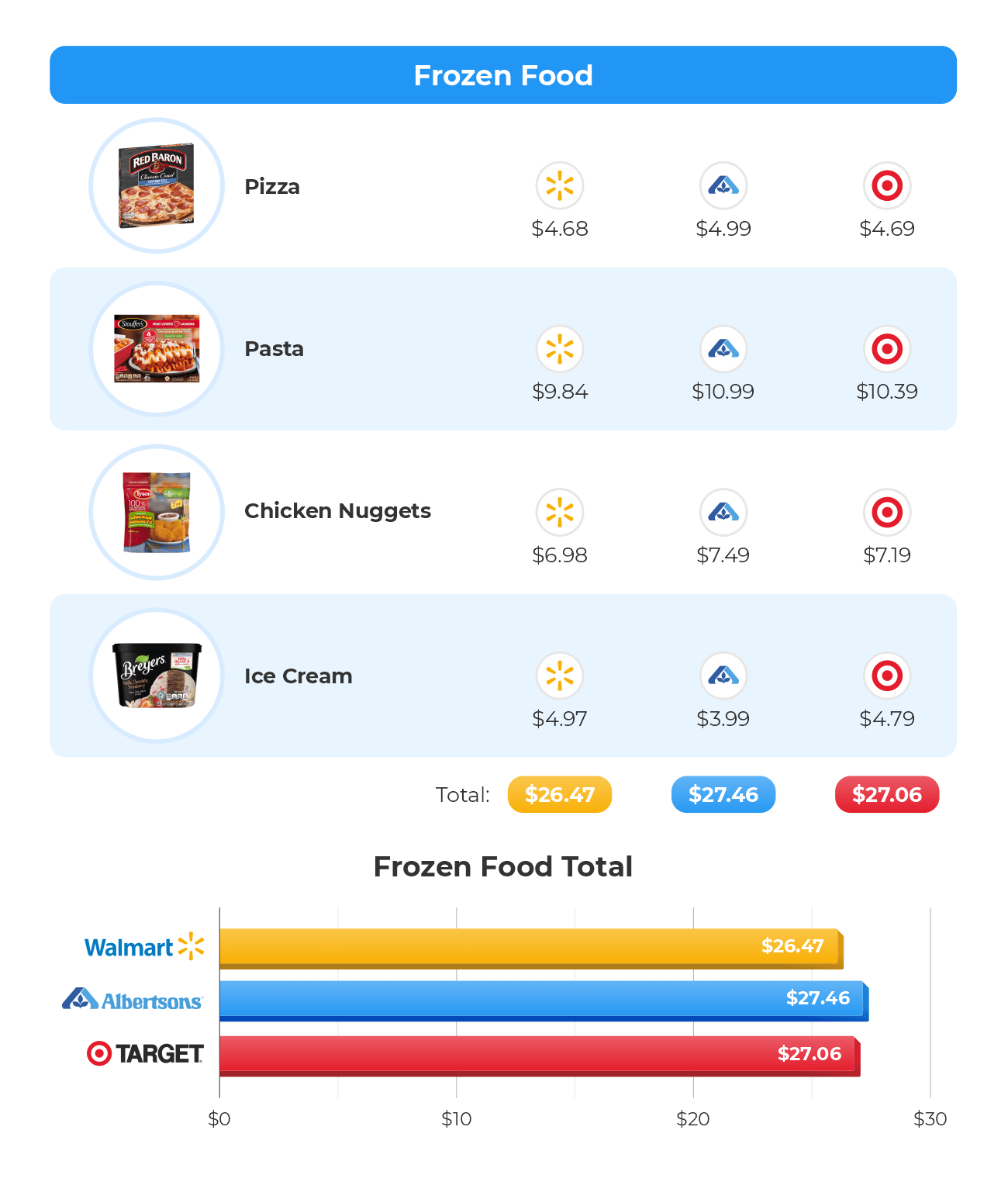
Within the Frozen Foods category, we’ve selected four products, namely ice cream, chicken nuggets, pizza, and some frozen pasta since they are universally loved (the ice cream, of course) and preferred by millions of shoppers for their convenience. The total cost for these items is $26.47 at Walmart, $27.06 at Target, and $27.46 at Albertsons, which means the prices in all three chains are very similar.
If we add all 37 items in our shopping cart, we would pay $23.68 more in Albertsons compared to Walmart, which is a difference of 12.65%. While at first glance, this may not be that much, such a difference could be really significant if we shop our groceries in bulk. However, note that this survey examines the prices of only a small portion of the thousands of foods and beverages sold at these three grocery chains, which is why it should not be considered representative of the current market.